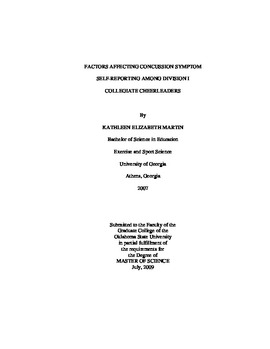| dc.contributor.advisor | Konz, Suzanne | |
| dc.contributor.author | Martin, Kathleen Elizabeth | |
| dc.date.accessioned | 2014-04-16T03:11:44Z | |
| dc.date.available | 2014-04-16T03:11:44Z | |
| dc.date.issued | 2009-07-01 | |
| dc.identifier.uri | https://hdl.handle.net/11244/9769 | |
| dc.description.abstract | The purpose of this research is to identify the reasons and factors that affect whether cheerleaders do or do not self-report concussions symptoms. Questionnaires were be used to identify perceived psychological, social, and environmental barriers or facilitators to self-reporting concussion symptoms in order to increase concussion reporting and reduce risk of further injury due to unreported symptoms and injuries. E-mails were sent to 168 collegiate cheerleaders at four universities in the NCAA Big 12 Conference, and 40 responded. Participants completed a web-based survey that consisted of 51 cheerleading-related questions addressing individuals' concussion reporting, injury reporting, and participation environment. Data was analyzed and six hypotheses tested. A statistically significant finding of this study was that the female respondents sustained a significantly lower number of concussions prior to the past year than males. Concussions were most commonly self-reported by cheerleaders in the NCAA Big 12 Conference to athletic trainers and that the most common reason for not reporting a concussion was that it was not thought to be serious enough. The majority of the collegiate cheerleaders in this study also agreed on average that they perceived social pressures that influenced their injury reporting. Concussion symptom self-reporting among cheerleaders is a multi-faceted issue and merits further study in order to gain a clearer, more complete understanding of the influencing factors. NCAA universities need to be prepared to deal with concussion injuries that result from participation to members of their cheerleading programs. The value of onsite certified athletic trainers should not be underestimated; they provide valuable concussion injury recognition, management, and education. Concussion baseline testing and multi-modal return-to-play approaches should be utilized with collegiate cheerleaders. Individual- and community-based educational initiatives need to be developed to aid in improving concussion self-reporting. | |
| dc.format | application/pdf | |
| dc.language | en_US | |
| dc.publisher | Oklahoma State University | |
| dc.rights | Copyright is held by the author who has granted the Oklahoma State University Library the non-exclusive right to share this material in its institutional repository. Contact Digital Library Services at lib-dls@okstate.edu or 405-744-9161 for the permission policy on the use, reproduction or distribution of this material. | |
| dc.title | Factors Affecting Concussion Symptom Self-Reporting Among Division I Collegiate Cheerleaders | |
| dc.type | text | |
| dc.contributor.committeeMember | Edwards, Steven | |
| dc.contributor.committeeMember | Miller, Bridget | |
| dc.contributor.committeeMember | Smith, Doug | |
| osu.filename | Martin_okstate_0664M_10454.pdf | |
| osu.college | Education | |
| osu.accesstype | Open Access | |
| dc.description.department | School of Teaching and Curriculum Leadership | |
| dc.type.genre | Thesis | |
